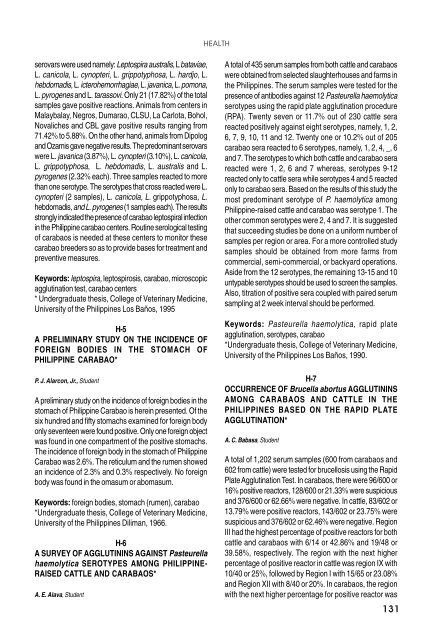THE PHILIPPINE WATER BUFFALO
THE PHILIPPINE WATER BUFFALO
THE PHILIPPINE WATER BUFFALO
Create successful ePaper yourself
Turn your PDF publications into a flip-book with our unique Google optimized e-Paper software.
serovars were used namely: Leptospira australis, L bataviae,<br />
L. canicola, L. cynopteri, L. grippotyphosa, L. hardjo, L.<br />
hebdomadis, L. icterohemorrhagiae, L. javanica, L. pomona,<br />
L. pyrogenes and L. tarassovi. Only 21 (17.82%) of the total<br />
samples gave positive reactions. Animals from centers in<br />
Malaybalay, Negros, Dumarao, CLSU, La Carlota, Bohol,<br />
Novaliches and CBL gave positive results ranging from<br />
71.42% to 5.88%. On the other hand, animals from Dipolog<br />
and Ozamis gave negative results. The predominant serovars<br />
were L. javanica (3.87%), L. cynopteri (3.10%), L. canicola,<br />
L. grippotyphosa, L. hebdomadis, L. australis and L.<br />
pyrogenes (2.32% each). Three samples reacted to more<br />
than one serotype. The serotypes that cross reacted were L.<br />
cynopteri (2 samples), L. canicola, L. grippotyphosa, L.<br />
hebdomadis, and L. pyrogenes (1 samples each). The results<br />
strongly indicated the presence of carabao leptospiral infection<br />
in the Philippine carabao centers. Routine serological testing<br />
of carabaos is needed at these centers to monitor these<br />
carabao breeders so as to provide bases for treatment and<br />
preventive measures.<br />
Keywords: leptospira, leptospirosis, carabao, microscopic<br />
agglutination test, carabao centers<br />
* Undergraduate thesis, College of Veterinary Medicine,<br />
University of the Philippines Los Baños, 1995<br />
H-5<br />
A PRELIMINARY STUDY ON <strong>THE</strong> INCIDENCE OF<br />
FOREIGN BODIES IN <strong>THE</strong> STOMACH OF<br />
<strong>PHILIPPINE</strong> CARABAO*<br />
P. J. Alarcon, Jr., Student<br />
A preliminary study on the incidence of foreign bodies in the<br />
stomach of Philippine Carabao is herein presented. Of the<br />
six hundred and fifty stomachs examined for foreign body<br />
only seventeen were found positive. Only one foreign object<br />
was found in one compartment of the positive stomachs.<br />
The incidence of foreign body in the stomach of Philippine<br />
Carabao was 2.6%. The reticulum and the rumen showed<br />
an incidence of 2.3% and 0.3% respectively. No foreign<br />
body was found in the omasum or abomasum.<br />
Keywords: foreign bodies, stomach (rumen), carabao<br />
*Undergraduate thesis, College of Veterinary Medicine,<br />
University of the Philippines Diliman, 1966.<br />
H-6<br />
A SURVEY OF AGGLUTININS AGAINST Pasteurella<br />
haemolytica SEROTYPES AMONG <strong>PHILIPPINE</strong>-<br />
RAISED CATTLE AND CARABAOS*<br />
A. E. Alava, Student<br />
HEALTH<br />
A total of 435 serum samples from both cattle and carabaos<br />
were obtained from selected slaughterhouses and farms in<br />
the Philippines. The serum samples were tested for the<br />
presence of antibodies against 12 Pasteurella haemolytica<br />
serotypes using the rapid plate agglutination procedure<br />
(RPA). Twenty seven or 11.7% out of 230 cattle sera<br />
reacted positively against eight serotypes, namely, 1, 2,<br />
6, 7, 9, 10, 11 and 12. Twenty one or 10.2% out of 205<br />
carabao sera reacted to 6 serotypes, namely, 1, 2, 4, _, 6<br />
and 7. The serotypes to which both cattle and carabao sera<br />
reacted were 1, 2, 6 and 7 whereas, serotypes 9-12<br />
reacted only to cattle sera while serotypes 4 and 5 reacted<br />
only to carabao sera. Based on the results of this study the<br />
most predominant serotype of P. haemolytica among<br />
Philippine-raised cattle and carabao was serotype 1. The<br />
other common serotypes were 2, 4 and 7. It is suggested<br />
that succeeding studies be done on a uniform number of<br />
samples per region or area. For a more controlled study<br />
samples should be obtained from more farms from<br />
commercial, semi-commercial, or backyard operations.<br />
Aside from the 12 serotypes, the remaining 13-15 and 10<br />
untypable serotypes should be used to screen the samples.<br />
Also, titration of positive sera coupled with paired serum<br />
sampling at 2 week interval should be performed.<br />
Keywords: Pasteurella haemolytica, rapid plate<br />
agglutination, serotypes, carabao<br />
*Undergraduate thesis, College of Veterinary Medicine,<br />
University of the Philippines Los Baños, 1990.<br />
H-7<br />
OCCURRENCE OF Brucella abortus AGGLUTININS<br />
AMONG CARABAOS AND CATTLE IN <strong>THE</strong><br />
<strong>PHILIPPINE</strong>S BASED ON <strong>THE</strong> RAPID PLATE<br />
AGGLUTINATION*<br />
A. C. Babasa, Student<br />
A total of 1,202 serum samples (600 from carabaos and<br />
602 from cattle) were tested for brucellosis using the Rapid<br />
Plate Agglutination Test. In carabaos, there were 96/600 or<br />
16% positive reactors, 128/600 or 21.33% were suspicious<br />
and 376/600 or 62.66% were negative. In cattle, 83/602 or<br />
13.79% were positive reactors, 143/602 or 23.75% were<br />
suspicious and 376/602 or 62.46% were negative. Region<br />
III had the highest percentage of positive reactors for both<br />
cattle and carabaos with 6/14 or 42.86% and 19/48 or<br />
39.58%, respectively. The region with the next higher<br />
percentage of positive reactor in cattle was region IX with<br />
10/40 or 25%, followed by Region I with 15/65 or 23.08%<br />
and Region XII with 8/40 or 20%. In carabaos, the region<br />
with the next higher percentage for positive reactor was<br />
131


